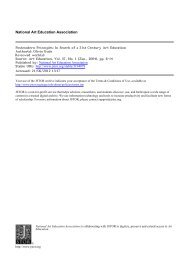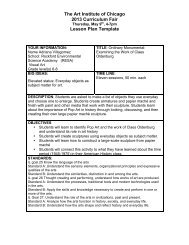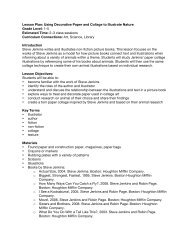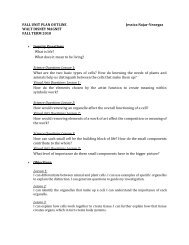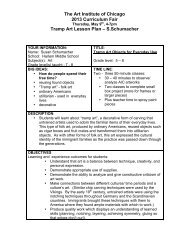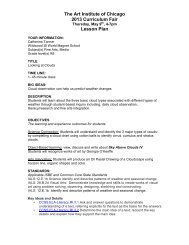Lesson 1 - LearningThroughMuseums
Lesson 1 - LearningThroughMuseums
Lesson 1 - LearningThroughMuseums
Create successful ePaper yourself
Turn your PDF publications into a flip-book with our unique Google optimized e-Paper software.
Chart: Symbols organizer. They can work in pairs or individually to complete the observation<br />
section at the top.<br />
3. Introduce information discussing the type of art (textiles) and its purpose (a map).<br />
4. Ask the students to list two ways the textile maps are alike and different—the bottom half of<br />
the Art Chart.<br />
5. Discuss how and why people make and use maps to show important features of a place.<br />
6. Ask students to infer why the people who made these maps made them the way they did.<br />
7. Ask the students to analyze the maps. What do the colors, words, images, and shapes represent<br />
in the two works? What do they symbolize? What do the student infer that the symbols show<br />
about the United States?<br />
8. Then give students the Symbols Show and Tell organizer to complete with a partner.<br />
9. Conclude the session by adding students’ statements to the “What We Know about Symbols”<br />
list.<br />
Day 2: Analyzing and Inferring Ideas from Symbols<br />
● Time Allotment<br />
45-60 minutes<br />
● Materials<br />
Materials for each student:<br />
Copy of the reading “Symbols, Maps and Art”<br />
Copy of the Summarize What you Learned organizer (this is optional; it can be used to<br />
organize the Extended Response)<br />
● Vocabulary<br />
artist<br />
comparison<br />
contrast<br />
mapmaker<br />
map key<br />
summarize<br />
● Procedure<br />
1. Explain that a summary is a way of telling the most important parts of something.<br />
2. Guide students to make a class summary of what they learned from the first day of the lesson.<br />
3. Give each student a copy of the reading “Symbols, Maps, and Art.” Students can complete the<br />
reading and related questions independently or with a learning partner.<br />
4. Discuss what students learned and prepare another class summary of this session’s learning.<br />
5. Add more notes to the “What We Know about Symbols” list.<br />
110 • <strong>Lesson</strong> 7: How to Read Symbols



